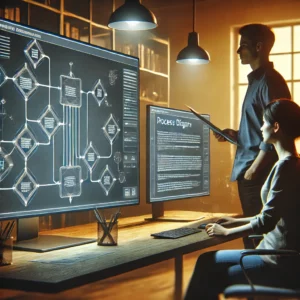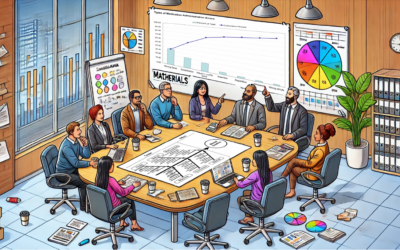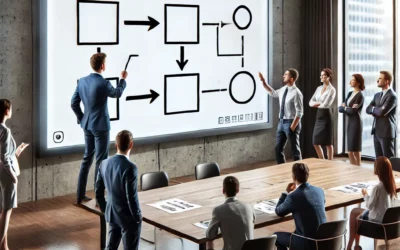Business and Digital Transformation Needs a Vision
Implementing Enterprise Resource Planning (ERP) and other operating systems in a business environment is a complex endeavor that demands meticulous planning and execution. Visual models have emerged as indispensable tools in this process, offering clarity and enhancing communication among stakeholders. These models facilitate a comprehensive understanding of system requirements, streamline implementation, and ultimately contribute to the success of ERP deployments.
Visual Advantages
One of the primary advantages of visual models is their ability to capture and analyze software requirements effectively. By transcending the limitations of text-based data, visual models rigorously identify, capture, and validate requirements, ensuring a complete system design. This approach has been applied successfully in numerous large-scale projects, leading to better business outcomes. “They allow you to look at the problem or requirements space at different levels of detail (Business Model Canvas shows you the entire organisation; a process model shows you a process which may span many different business areas over a long period of time; a prototype shows you what one person does at one point of time with a digital device);” 3
 In the context of ERP systems like Infor Visual ERP, visual models play a pivotal role in optimizing production and enhancing customer satisfaction. Features such as ‘what-if’ delivery models enable businesses to secure shop-floor capacity and optimize schedules, aligning operations with real-time data. This adaptability to industry-specific requirements makes visual ERP solutions a preferred choice for manufacturers seeking a competitive edge.
In the context of ERP systems like Infor Visual ERP, visual models play a pivotal role in optimizing production and enhancing customer satisfaction. Features such as ‘what-if’ delivery models enable businesses to secure shop-floor capacity and optimize schedules, aligning operations with real-time data. This adaptability to industry-specific requirements makes visual ERP solutions a preferred choice for manufacturers seeking a competitive edge.
The deployment of visual ERP systems involves a structured approach that includes building a company culture of adoption and effective utilization of the new system. Leveraging decades of ERP implementation experience, firms proficient in visual ERP can significantly enhance a business’s operational efficiency. Their deep understanding of visual ERP’s capabilities positions them as valuable partners in optimizing ERP strategies.
Moreover, visual models are instrumental in redesigning operating models to unlock the full benefits of ERP systems. As organizations increasingly adopt ERP solutions to remain competitive, having the right operating model design and organizational structure becomes critical. Visual models aid in this transformation by providing clear representations of processes and systems, enabling better decision-making during and after ERP deployment.
Without a Vision …
Implementing an ERP system without utilizing visual models can lead to several significant challenges that impede project success.
One major issue is poor planning and unclear goals. Without visual models to map out business processes and workflows, organizations may struggle to define clear objectives and project scopes, leading to confusion and delays during implementation. As noted by John Talio Consulting, “Jumping into an ERP implementation without a clear roadmap can lead to confusion and delays.”
Another challenge is data quality issues. Visual models assist in understanding data flows and relationships within the organization. Without them, data migration can result in incomplete, inconsistent, or inaccurate data being transferred into the new ERP system, compromising its performance. ITRex Group highlights that “One of the major challenges of ERP implementation is data quality,” emphasizing the importance of proper data management.
Additionally, resistance to change and user adoption can be exacerbated in the absence of visual models. These models play a crucial role in illustrating new processes and system functionalities, aiding in user understanding and acceptance. Without them, employees may resist adopting the new system due to a lack of clarity and perceived complexity. As noted by ITRex Group, “Resistance to change among employees is one of the most common ERP implementation challenges.”
So, neglecting the use of visual models during ERP implementation can lead to poor planning, data quality issues, and increased resistance to change, all of which can significantly hinder the success of the project.
Where to Start
Business analysts utilize a variety of visual models to enhance project outcomes. Models such as data flow diagrams, data models, and process flow diagrams help in understanding complex systems, exploring design alternatives, and forming a foundation for implementation. These visual tools improve communication within teams and provide an unambiguous basis for system development.
Creating these models is at the heart of what Work-Flow.studio helps to do. Using collaborative, online tools, all of the necessary visual representations can be created to ensure a proper basis for digital transformation.
Conclusion
In conclusion, visual models are vital in the implementation of ERP and other operating systems within businesses. They enhance understanding, facilitate effective communication, and provide a solid foundation for system design and deployment. By employing visual models, organizations can navigate the complexities of ERP implementation more efficiently, leading to improved operational performance and a stronger competitive position in the market.
References and Links
- John Talio Consulting
Common Challenges in ERP Implementations and How to Avoid Them
- ITRex Group
ERP Implementation Challenges
https://itrexgroup.com/blog/erp-implementation-challenges/
- Business Analyst Mentor
How the Use of Visual Models Will Significantly Improve the Quality of Your Requirements
- Geeky Gadgets
Benefits of Implementing Visual Systems in Business
https://www.geeky-gadgets.com/benefits-of-implementing-visual-systems-in-business/
- iOSR Journals
ERP Implementation and Organizational Effectiveness
https://www.iosrjournals.org/iosr-jbm/papers/Vol23-issue5/Series-4/B2305040613.pdf
- Fanap Research Journal
Redesigning Operating Models for ERP Success
https://journal.research.fanap.com/article_111141_81996cb945e1fb3f8c0276afca721c30.pdf
- Modern Analyst
Why Modeling Is an Essential Business Analysis Technique







0 Comments